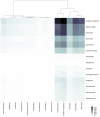Candyflipping and Other Combinations: Identifying Drug-Drug Combinations from an Online Forum
- PMID: 29760666
- PMCID: PMC5936764
- DOI: 10.3389/fpsyt.2018.00135
Candyflipping and Other Combinations: Identifying Drug-Drug Combinations from an Online Forum
Abstract
Novel psychoactive substances (NPS) refer to synthetic compounds or derivatives of more widely known substances of abuse that have emerged over the last two decades. Case reports suggest that users combine substances to achieve desired psychotropic experiences while reducing dysphoria and unpleasant somatic effects. However, the pattern of combining NPS has not been studied on a large scale. Here, we show that posts discussing NPS describe combining nootropics with sedative-hypnotics and stimulants with plant hallucinogens or psychiatric medications. Discussions that mention sedative-hypnotics most commonly also mention hallucinogens and stimulants. We analyzed 20 years of publicly available posts from Lycaeum, an Internet forum dedicated to sharing information about psychoactive substance use. We used techniques from natural language processing and machine learning to identify NPS and correlate patterns of co-mentions of substances across posts. We found that conversations mentioning synthetic hallucinogens tended to divide into those mentioning hallucinogens derived from amphetamine and those derived from ergot. Conversations that mentioned synthetic hallucinogens tended not to mention plant hallucinogens. Conversations that mention bath salts commonly mention sedative-hypnotics or nootropics while more canonical stimulants are discussed with plant hallucinogens and psychiatric medications. All types of substances are frequently compared to MDMA, DMT, cocaine, or atropine when trying to describe their effects. Our results provide the largest analysis to date of online descriptions of patterns of polysubstance use and further demonstrate the utility of social media in learning about trends in substance use. We anticipate this work to lead to a more detailed analysis of the knowledge contained online about the patterns of usage and effects of novel psychoactive substances.
Keywords: computational biology; computer simulation; natural language processing; psychedelic drug use; toxicology.
Figures




Similar articles
-
Use of synthetic stimulants and hallucinogens in a cohort of electronic dance music festival attendees.Forensic Sci Int. 2018 Jan;282:168-178. doi: 10.1016/j.forsciint.2017.11.017. Epub 2017 Nov 21. Forensic Sci Int. 2018. PMID: 29216523
-
Self-reported use of novel psychoactive substances in a US nationally representative survey: Prevalence, correlates, and a call for new survey methods to prevent underreporting.Drug Alcohol Depend. 2015 Nov 1;156:112-119. doi: 10.1016/j.drugalcdep.2015.08.028. Epub 2015 Sep 3. Drug Alcohol Depend. 2015. PMID: 26377051 Free PMC article.
-
The users of Novel Psychoactive Substances: Online survey about their characteristics, attitudes and motivations.Int J Drug Policy. 2016 Jun;32:77-84. doi: 10.1016/j.drugpo.2016.03.007. Epub 2016 Mar 23. Int J Drug Policy. 2016. PMID: 27184218
-
Novel psychoactive substances: the pharmacology of stimulants and hallucinogens.Expert Rev Clin Pharmacol. 2016 Jul;9(7):943-54. doi: 10.1586/17512433.2016.1167597. Epub 2016 Apr 4. Expert Rev Clin Pharmacol. 2016. PMID: 26985969 Review.
-
Psychedelic Fauna for Psychonaut Hunters: A Mini-Review.Front Psychiatry. 2018 May 22;9:153. doi: 10.3389/fpsyt.2018.00153. eCollection 2018. Front Psychiatry. 2018. PMID: 29910745 Free PMC article. Review.
Cited by
-
Nootropics as Cognitive Enhancers: Types, Dosage and Side Effects of Smart Drugs.Nutrients. 2022 Aug 17;14(16):3367. doi: 10.3390/nu14163367. Nutrients. 2022. PMID: 36014874 Free PMC article. Review.
-
Machine Learning and Natural Language Processing in Mental Health: Systematic Review.J Med Internet Res. 2021 May 4;23(5):e15708. doi: 10.2196/15708. J Med Internet Res. 2021. PMID: 33944788 Free PMC article.
-
Sublethal toxicities of 2,4-dinitrophenol as inferred from online self-reports.PLoS One. 2023 Sep 13;18(9):e0290630. doi: 10.1371/journal.pone.0290630. eCollection 2023. PLoS One. 2023. PMID: 37703241 Free PMC article.
-
Mining social media for prescription medication abuse monitoring: a review and proposal for a data-centric framework.J Am Med Inform Assoc. 2020 Feb 1;27(2):315-329. doi: 10.1093/jamia/ocz162. J Am Med Inform Assoc. 2020. PMID: 31584645 Free PMC article. Review.
-
Text classification models for the automatic detection of nonmedical prescription medication use from social media.BMC Med Inform Decis Mak. 2021 Jan 26;21(1):27. doi: 10.1186/s12911-021-01394-0. BMC Med Inform Decis Mak. 2021. PMID: 33499852 Free PMC article.
References
-
- Orsolini L, Papanti D, Vecchiotti R, Valchera A, Corkery J, Schifano F. Novel psychoactive substances. Eur Psychiatry (2016) 33:S59–60. 10.1016/j.eurpsy.2016.01.945 - DOI
LinkOut - more resources
Full Text Sources
Other Literature Sources

